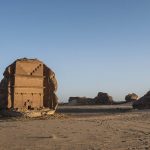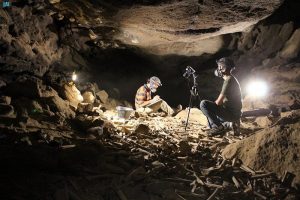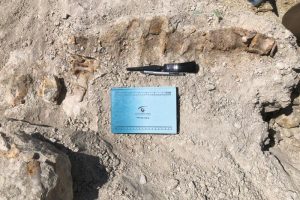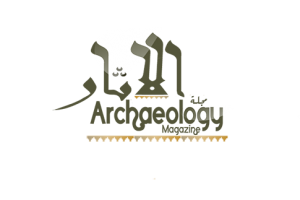
As previously announced by HH Prince Sultan Bin Salman at the French Academy of Inscriptions and Belles-Lettres:
Nature Ecology & Evolution: the discovery of human fossils in Taima (Saudi Arabia) has received widespread attention in global research centres
Nature Ecology & Evolution, the renowned international journal dedicated to human research and studies, highlighted the discovery of the first human remains near the Saudi city of Taima, estimated to date back to more than 85,000 years. The discovery was announced by His Royal Highness Prince Sultan Bin Salman Bin Abdul Aziz, President of the Saudi Commission for Tourism and National Heritage, in a lecture at the French Academy for Inscriptions and Belles-Lettres in Paris in June 2016.
The journal highlighted the significance of this fossil, discovered in Wusta site near Kuthaib Al-Ghadha, located in Nafud Taima in Tabuk Province as a result of the Saudi-German mission under the Green Arabia Project in 2014, where a phalanx of a human middle finger was found, estimated to date back to more than 85,000 years.
The article included detailed information on the efforts of the Green Arabia Project, a joint program focusing on the study of ancient environments in Arabia carried out by the Saudi Commission for Tourism and National Heritage, the Saudi Geological Survey, the College of Tourism and Antiquities at King Saud University, the Max Planck Institute in Germany, and international centres specialized in archaeology.
The article stated that the team excavated a grid of eight squares where fossils, artefacts, vertebrae, and stone tools were found next to the human finger. In addition, 380 stone tools were found which clearly shows the manufacturing techniques of the ancient Middle Stone Age, mostly from chert and quartzite. These tools were similar to those found across the eastern and north-eastern parts of Africa.
The journal confirmed that the Al Wusta intermediate phalanx to be the oldest fossil to be found outside Africa and the Levant. Its discovery emphasizes the presence of humans in Arabia. Early H. sapiens dispersals out of Africa were not limited to winter rainfall-fed Levantine Mediterranean woodlands, but extended deep into the semi-arid grasslands of Arabia, facilitated by periods of enhanced monsoonal rainfall.
It was stated in the journal that such a discovery resonated loudly within international research centres, pointing out the significance of such a discovery; dispersals of early humans outside Africa into Arabia more than 85 thousand years ago through dating the oldest human fossil found in Al Wusta site.
The journal reported that it has been argued that dispersal out of Africa had an early phase, particularly ~130–90 thousand years ago (ka), that reached only the East Mediterranean Levant, and a later phase, ~60–50 ka, that extended across the diverse environments of Eurasia to Sahul.
The paper included detailed information on the results of the team’s efforts, i.e. they were able to extract 860 mammal fossils from AlWusta site, most significantly hippos, pelorovis and kobus. This indicates a close association with animals that originated in Africa; it turned out that the age of the hippopotamus tooth enamel dated back 83,000 years and the root dated back 65,000 years old. All these fossils were deposited about 92,200 years ago.
The journal added that this fossil was subject to various analytical studies in specialized laboratories outside the Kingdom of Saudi Arabic to identify its characteristics and compare them with those found in other sites outside Arabia.
It is worth mention that His Royal Highness Prince Sultan Bin Salman Bin Abdul Aziz, President of the Saudi Commission for Tourism and National Heritage, announced in a lecture delivered at the French Academy of Inscriptions and Belles-Lettres in Paris in June 2016, the latest major discoveries made in Saudi Arabia was the discovery of a human bone found in the dry lake in Taima, considered to be the oldest human remains found in the Arabian Peninsula.
His Highness pointed out that the latest discoveries have proved the existence of ancient lakes and rivers which were prevalent in the Arabian Peninsula at the time. This is scientific evidence proving the prophecy of our Prophet peace be upon him fifteen centuries ago, when he said peace be upon him that: “The Hour (of Resurrection) will not occur until the Arabian Peninsula returns, as it used to be, meadows and rivers”. This is a definite indication that it was such, and that is what we believe in without any doubt or suspicion. But, we now have scientific indications proving that the Arabian Peninsula was lush with meadows and networks of rivers.
His Highness pointed out that the Saudi Commission for Tourism and National Heritage launched the Green Arabia Project back in 2012 in cooperation with Oxford University as an initiative to study the relationship between the climatic changes which took place in the Arabian Peninsula throughout the ages and the beginning of human settlement and human migration there across the continents of the ancient world until now. He disclosed that a fossil of an elephant tusk had been found in the western parts of the Nufud desert, among a large number of mammal fossils including gazelles, as well as the Arabian Oryx, cows, wild buffaloes, horses, wolves, hippos, tigers, birds and elephants. The site is an ancient lake where archaeological and geological evidence suggests it dates back five hundred thousand years. Whereas, fossils uncovered at the site have been found to date back to around 335 thousand years (BP).














